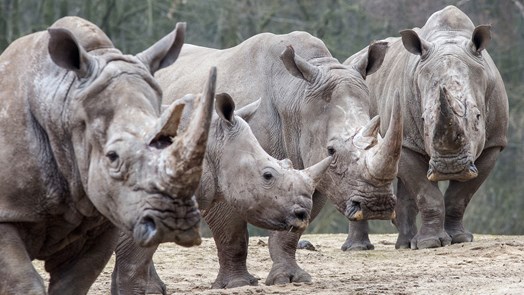Ruben takes care of square-lipped rhinos
Thursday, 10 November 2022

Square-lipped rhinos capture the imagination of many visitors: the colossal, somewhat prehistoric-looking mammals inspire admiration and awe. While impressive to behold, rhinos are less dangerous than many people think. “Square-lipped rhinos are actually extremely quiet, peaceful animals,” explains head keeper Ruben. An adult square-lipped rhinoceros bull can weigh up to 3,000 kilos, while cows usually reach around 2,000 kilos. Despite their demure nature, their incredible weight and great pushing force mean you want to avoid unintentionally ending up between a rhino and the wall. “As zookeepers, we are careful never to underestimate the incredible power of these large mammals, and we always work hands-off with the rhinos. That includes never being in the enclosure at the same time as the animals. But rhinos certainly do not have an aggressive, hot-tempered nature—they are gentle giants.
At the time of writing, autumn is fully underway at the zoo, which means Ruben and his fellow zookeepers have an extra task when it comes to caring for the rhinos. “We spend the early mornings blowing leaves before the rhinos leave their heated indoor enclosures and head towards the savannah plain through a specially fenced-off corridor. The rhinos love the freshly fallen leaves; if we don’t clear the path first, they will continuously stop to eat all those tasty leaves. Just try to get those thousands of kilos again,” Ruben smiles. “It’s a standard autumn chore when caring for the rhinos.”

To further encourage the grey giants to keep up the pace on their walk from the stables to the savannah plain in the morning, Ruben and his colleagues recently started laying out pellets on two plates at the beginning of the plain. The intelligent animals seem to quickly realise that there is a tasty reward waiting for them and usually set off enthusiastically. “Sometimes, the animals can be quite impressed by seemingly small changes. They are in awe of electric fencing, for example, but often react surprisingly cautiously and warily to other small adjustments or changes. Rhinos are rather nearsighted, which may play a role in that.” One extraordinary detail that inquisitive, exploring rhinos have is their flexible auricles, which work like directional antennae that they can individually turn toward sounds.
In the stables, Ruben and his fellow zookeepers use a special biofloor consisting of layers of bark over a metre deep. The urine sinks into the floor, so the animals do not have to walk in their own urine. The soft bark floor also acts as a wonderful, naturally springy mattress for the animals as they lie down to rest at night. When the animals go out in the morning, Ruben and his colleagues clear the manure from the stables daily. They put out new hay bales and add pellets later in the afternoon, just before the animals come back in.
Burgers’ Zoo has been very successful in breeding square-lipped rhinos for many years; we are in the top five in Europe in that regard. Of the five rhino species in the world, the square-lipped rhino is still the most plentiful in the wild, with an estimated population of about 18,000 animals. Nevertheless, the IUCN Red List lists it as “Near Threatened”, and many animals fall victim to poachers every year. In Arnhem, we have two adult cows and a fertile bull who together ensure steady growth in the rhino population. After a gestation period of about 17 months, a single calf is born. A newborn square-lipped rhinoceros weighs around 60 kilos and can gain as much as 1.5 kilos every day for the first few weeks after birth just by drinking milk from its mother. Only later does it start eating solid food such as hay and pellets.

Like in the wild, our adult bull leads a solitary life. When cows are not meant to be mated again, the bull is kept in a large enclosure behind the scenes. Even when the bull shares the savannah plain in Arnhem with the adult cows and their calves, he tends to do his own thing. In the wild, a rhino bull marks his territory with urine and piles of dung deposited along the borders. Bulls tolerate cows entering their territory but will try to chase away rival adult bulls.
“The cows and their calves often head out to the plain first, followed by the adult bull. We often see the bull sniffing the cows’ dung to determine whether they are in heat. After that, the bull usually deposits his scent as a marker by scraping the ground with his hind legs and applying scent flags with urine,” Ruben explains. “We see the bull exhibit his natural marking behaviour here in the zoo as well.”

“Each rhino has its own character—that varies distinctly from animal to animal. At some point, as a zookeeper, you know from experience exactly what to expect from each animal and the best way to approach it,” Ruben says. “We recently set up a new feeding area outside on the plain specifically for the rhinos. We laid logs around the feeding area, which the animals love rubbing their horns on. The logs have been worn down all around and hollowed out in a few places. The square-lipped rhinos eat mainly hay, supplemented by pellets for grazers specially developed for our zoo. They sometimes nibble on the fresh branches we provide for other species, but square-lipped rhinos are primarily grazers. Their wide mouths are built entirely for that, as you can see: the square-lipped rhinoceros certainly lives up to its name.”



